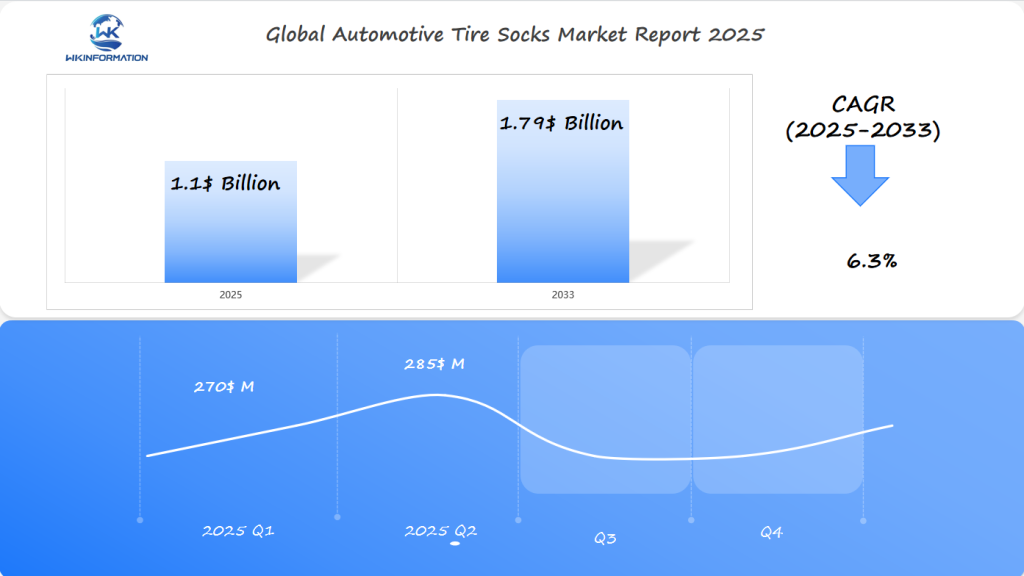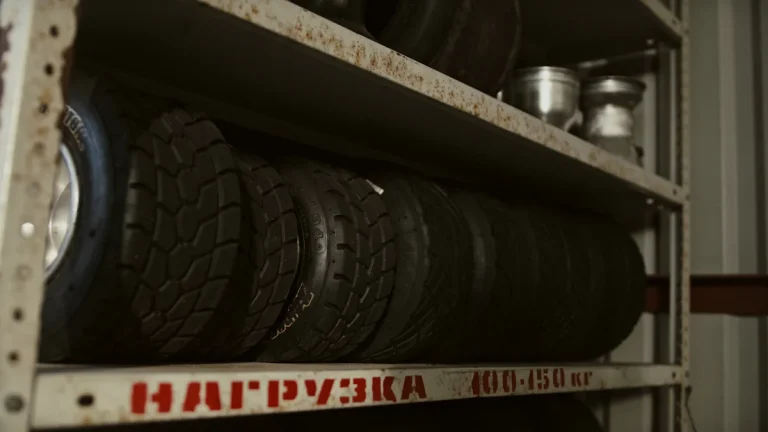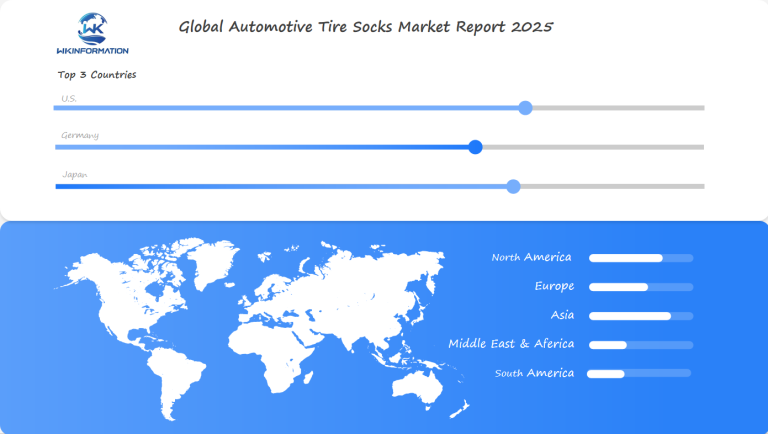$1.1 Billion Automotive Tire Socks Market Expected to Grow in the U.S., Germany, and Japan by 2025
The market size will reach USD 1.1 billion in 2025 and is expected to reach USD 1.79 billion by 2033, with a CAGR of 6.3% from 2025 to 2033.
- Last Updated:
Projected Market Insights for Automotive Tire Socks in Q1 and Q2 of 2025
The Automotive Tire Socks market is projected to reach $1.1 billion in 2025, with a CAGR of 6.3% from 2025 to 2033. In Q1, the market is expected to generate approximately $270 million, driven by rising consumer demand for innovative, cost-effective solutions for tire safety, especially in winter conditions. By Q2, the market is expected to grow to about $285 million, reflecting ongoing demand in both personal and commercial vehicle sectors.
Japan, the U.S., and Germany are expected to lead the market, with Japan’s cold climate and strong automotive industry driving adoption, the U.S.’s large vehicle fleet increasing tire safety concerns, and Germany’s advanced automotive sector further accelerating the market. As tire socks offer a practical alternative to traditional snow chains, their increasing popularity due to convenience and cost-effectiveness will continue to fuel growth in these regions.

Understanding the Upstream and Downstream Industry Chains for Automotive Tire Socks
The automotive tire socks market relies heavily on a complex network of upstream suppliers and downstream distributors.
Upstream Suppliers: The Backbone of Production
Upstream suppliers, mainly textile manufacturers, are essential in supplying the raw materials needed to produce tire socks. These materials need to be strong yet flexible to guarantee the product’s efficiency in improving grip on snowy roads.
Downstream Distributors: Connecting Products to Consumers
Downstream distributors play a crucial role in the industry chain. Retailers, whether online or physical stores, are responsible for ensuring that tire socks are easily available to consumers. Their responsibilities go beyond just distributing products; they also shape how consumers perceive the brand through their marketing strategies and customer service initiatives.
The Importance of a Strong Supply Chain
A strong supply chain is crucial for keeping the balance between demand and supply, making sure that tire socks are easily accessible during busy winter seasons. If there’s any disruption in this chain, it can result in shortages, impacting consumers’ ability to buy these necessary winter driving aids.
Effective supply chain management guarantees that top-notch products reach consumers quickly and efficiently. This is especially important as the demand for tire socks continues to rise due to more people owning vehicles and a greater emphasis on road safety awareness.
Technology’s Role in Enhancing Efficiency
The integration of technology, particularly AI, into supply chain operations further enhances efficiency. This enables real-time tracking and inventory management that align with market demands. Such advancements are part of a broader trend in transforming supply chains, where seamless collaboration between upstream and downstream players is pivotal in sustaining market growth.
Key Trends Driving the Automotive Tire Socks Market
Several key trends are accelerating the growth of the automotive tire socks market. A significant factor is the increasing vehicle ownership in emerging markets. Rising disposable incomes and urbanization, particularly in countries like China and India, are driving vehicle sales. This surge in vehicle ownership leads to a higher demand for winter driving solutions, including tire socks, which are essential for navigating snowy and icy conditions safely.
Government regulations on road safety also play a crucial role. Stringent regulations aimed at enhancing road safety standards have been implemented, especially in regions with harsh winter climates where tire sock usage is more prevalent. These regulations often mandate the use of traction aids during winter months, positioning tire socks as a practical alternative to traditional chains.
The demand for eco-friendly products is another trend influencing this market. Consumers are increasingly seeking environmentally sustainable alternatives. In response, manufacturers are developing tire socks made from sustainable materials, aligning with broader environmental sustainability goals within the automotive industry. This shift reflects a growing awareness and preference for products that reduce environmental impact while maintaining performance standards.
Collectively, these trends underscore a dynamic market landscape where vehicle ownership, regulatory frameworks, and consumer preferences converge to drive innovation and growth in the automotive tire socks sector.
Challenges in Manufacturing Automotive Tire Socks
Manufacturing high-quality automotive tire socks presents several production challenges that manufacturers need to address to remain competitive in the automotive tire socks market.
1. Material Durability Issues
Ensuring that tire socks are durable enough to withstand harsh winter conditions while maintaining the necessary flexibility is a significant challenge. The selection of materials must balance these attributes to ensure performance and longevity. Textile fibers need to be strong yet pliable, which complicates the material selection process and requires ongoing innovation.
2. Cost Efficiency Concerns
Rising raw material prices directly affect production costs, impacting pricing competitiveness within the market. Manufacturers must navigate these cost factors by optimizing production processes and sourcing strategies. This economic pressure can lead to increased consumer prices, potentially affecting demand.
3. Competition with Traditional Tire Chains
Tire sock manufacturers face stiff competition from established players offering traditional tire chains at generally lower price points. Although tire socks provide advantages like ease of installation and lighter weight, they often lack the traction on ice that chains offer, necessitating manufacturers to continuously improve their products to maintain market relevance.
Meeting these challenges is crucial for manufacturers aiming to capitalize on growth opportunities in the automotive tire socks market, especially as demand increases in major regions like the U.S., Germany, and Japan.

Geopolitical Factors Affecting the Automotive Tire Socks Market
The automotive tire socks market is significantly influenced by trade policies and international relations, affecting both supply chains and market accessibility in different regional markets.
1. The U.S.
Trade tensions between the U.S. and China have led to higher tariffs on imported tire socks, which is changing the pricing dynamics in the domestic market. These tariffs may result in increased costs for consumers and impact the competitiveness of tire sock products compared to traditional solutions such as tire chains.
2. Germany
Germany plays a significant role in the automotive tire socks industry as both a producer and consumer. Its reputation as a center for innovation strengthens its influence in the market, but it is also susceptible to external political changes. For example, disruptions caused by Brexit could potentially impact its trade relationships and disrupt the stability of supply chains in Europe. Such vulnerabilities are highlighted in recent studies which explore the broader implications of political changes on industries like automotive in Germany.
3. Japan
Japan heavily depends on imports because it has limited manufacturing capabilities. This makes Japan vulnerable to changes in global trade agreements. Any shifts in international relations can affect Japan’s access to important materials and finished products, which in turn can impact the availability and prices for Japanese consumers.
These geopolitical factors highlight the need for businesses in the automotive tire socks market to have strategic planning and flexibility. It’s crucial for them to be able to navigate these intricate international situations successfully.
Market Segmentation: Types and Applications of Automotive Tire Socks
Automotive tire socks are a versatile solution for enhancing vehicle traction in winter conditions. Understanding the product types and application areas offers insight into their diverse uses and consumer segments.
Types of Tire Socks:
1. Standard Tire Socks:
- Designed for everyday passenger vehicles.
- Offer a balance between performance and cost.
- Suitable for occasional use during mild snow conditions.
2. Heavy-Duty Tire Socks:
- Engineered for commercial vehicles like trucks and buses.
- Built with more robust materials to withstand frequent use.
- Provide enhanced traction on snow and ice, catering to professional drivers facing harsh conditions regularly.
Application Areas:
1. Passenger Vehicles:
- Standard tire socks are popular among individual consumers who require an easy-to-install solution for unexpected snowfalls.
- These products cater to drivers seeking convenience without compromising safety.
2. Commercial Use:
- Heavy-duty options serve industries reliant on consistent transport logistics, such as delivery services and public transportation.
- The emphasis is on durability and effectiveness to ensure minimal disruption during winter months.
Understanding these categories helps identify how different consumer needs drive demand within the automotive tire socks market, reflecting the broader trends in winter driving solutions. This segmentation highlights the importance of tailoring products to meet specific user requirements across various sectors.
The Role of Technology in Shaping Automotive Tire Sock Design Innovations
Advancements in manufacturing techniques have significantly impacted the Automotive Tire Socks Market, bringing about innovative design changes.
**1. **Digital Knitting Technology
This advanced technique allows for precise control over fabric properties like thickness and stretchability. With this level of control, performance features can be enhanced, resulting in better grip and durability for winter driving situations.
2. Smart Sensors Integration
Emerging trends highlight the incorporation of smart sensors into tire socks. These sensors deliver real-time feedback on traction levels or wear patterns, allowing for proactive maintenance and enhancing overall safety for drivers navigating snow and ice-covered roads.
Global Insights on the Automotive Tire Socks Market
The global automotive tire socks market is growing as more consumers look for alternatives to traditional tire chains for winter driving. This growth is being fueled by the increasing awareness of the advantages of tire socks, such as their ease of use, portability, and safety in harsh weather conditions.
Key Markets for Tire Socks
- Europe
- North America
- Parts of Asia-Pacific
These regions are seeing a rise in demand for tire socks, particularly in areas that experience frequent winter weather.
Future Outlook
With ongoing innovations in materials and manufacturing technologies that enhance the efficiency and durability of tire socks, the market is expected to keep expanding. This presents opportunities for both established companies and new entrants in the industry.

U.S. Market Dynamics for Automotive Tire Socks Demand
In the United States, the demand for automotive tire socks is rising as winter driving safety concerns remain a priority, particularly in regions prone to heavy snow and ice. States in the northern U.S. such as Alaska, Minnesota, and Colorado are seeing an increase in the use of tire socks as a convenient, quick solution for vehicles during winter months.
The U.S. market is also being supported by:
- Increasing awareness among consumers about the advantages of tire socks over traditional snow chains, such as ease of installation and storage.
- Regulatory pressures and a growing focus on road safety are encouraging consumers to explore safer, more efficient winter driving accessories.
Germany’s Technological Influence on Automotive Tire Socks
Germany is known for its automotive industry and advanced engineering, and it plays a significant role in the development and adoption of automotive tire socks. The country experiences harsh winter conditions and has a high number of vehicles, making it an important market for tire socks.
Innovation in Tire Sock Technology
German manufacturers are leading the way in innovation when it comes to tire sock technology. They are focusing on:
- Improving material strength
- Enhancing water resistance
- Boosting traction performance
These technological advancements have made tire socks more appealing to consumers, as they provide an eco-friendly alternative to traditional snow chains.
Compatibility with High-Performance Vehicles
Germany’s automotive market is known for its emphasis on high-performance vehicles. As a result, there is a growing interest in tire socks that can be used with various types of vehicles, including passenger cars and trucks.
Japan’s Role in Automotive Tire Socks Market Growth
Japan is playing an increasingly important role in the growth of the automotive tire socks market. This is mainly due to the harsh winter conditions experienced in its northern regions, such as Hokkaido.
Growing Demand for Winter Driving Solutions
Japanese consumers are actively looking for practical and efficient solutions for winter driving. In this context, tire socks are gaining popularity as a convenient alternative to traditional snow chains, which can be bulky and difficult to handle.
Contributions from Japanese Manufacturers
Japanese manufacturers are also making significant contributions to the market by developing innovative tire sock designs. These designs prioritize qualities such as lightweight construction, durability, and user-friendliness, ultimately leading to improved performance and safety during snowy conditions.
Support from Technological Advancements
Furthermore, Japan’s reputation for technological advancements and its consumers’ interest in innovation are further bolstering the market for automotive tire socks. This makes Japan a crucial region for both domestic and international manufacturers looking to establish or expand their presence in this industry.
The Future Outlook for Automotive Tire Socks Market Growth Opportunities Beyond Traditional Applications
The Automotive Tire Socks Market is set to grow beyond its usual boundaries. Emerging markets offer great potential for expansion, with possible uses including:
- Heavy-duty Vehicles: Usage in buses and trucks operating in harsh winter conditions.
- Off-road and Recreational Vehicles: Enhancing safety during off-road adventures.
- Public Transportation Fleets: Ensuring continuous operation during snowstorms.
These opportunities highlight how tire socks can be adapted to meet various vehicle requirements, opening doors for creative uses and deeper market entry.
Competitive Landscape in the Automotive Tire Socks Industry
The automotive tire socks industry is highly competitive, with several key players striving to differentiate themselves through product quality, innovation, and customer service.
-
Michelin — France
-
Joubert Productions — France
-
AutoSock — Norway
-
Isse Safety — Sweden
-
TireSocks Inc. — USA
-
Novotool Industrial Co. Ltd — Taiwan
-
Dunlop — UK
Overall
| Report Metric | Details |
|---|---|
| Report Name | Global Automotive Tire Socks Market Report |
| Base Year | 2024 |
| Segment by Type |
|
| Segment by Application |
|
| Geographies Covered |
|
| Forecast units | USD million in value |
| Report coverage | Revenue and volume forecast, company share, competitive landscape, growth factors and trends |
The automotive tire socks market has great potential for growth. This is mainly due to the increasing demand for winter safety solutions and advancements in technology. Emerging markets present a smart investment opportunity, especially as manufacturers come up with new materials and adaptive technologies.
Even though there are challenges such as competition from traditional tire chains, the market still offers opportunities for expansion through strategic partnerships and targeted marketing. It is important for stakeholders to understand market trends and invest in product innovation in order to make the most of this dynamic environment.
By meeting consumer needs and exploring untapped regions, the market is likely to attract future investment.
Global Automotive Tire Socks Market Report (Can Read by Free sample) – Table of Contents
Chapter 1: Automotive Tire Socks Market Analysis Overview
- Competitive Forces Analysis (Porter’s Five Forces)
- Strategic Growth Assessment (Ansoff Matrix)
- Industry Value Chain Insights
- Regional Trends and Key Market Drivers
- Automotive Tire Socks MarketSegmentation Overview
Chapter 2: Competitive Landscape
- Global Automotive Tire Socks players and Regional Insights
- Key Players and Market Share Analysis
- Sales Trends of Leading Companies
- Year-on-Year Performance Insights
- Competitive Strategies and Market Positioning
- Key Differentiators and Strategic Moves
Chapter 3: Automotive Tire Socks Market Segmentation Analysis
- Key Data and Visual Insights
- Trends, Growth Rates, and Drivers
- Segment Dynamics and Insights
- Detailed Market Analysis by Segment
Chapter 4: Regional Market Performance
- Consumer Trends by Region
- Historical Data and Growth Forecasts
- Regional Growth Factors
- Economic, Demographic, and Technological Impacts
- Challenges and Opportunities in Key Regions
- Regional Trends and Market Shifts
- Key Cities and High-Demand Areas
Chapter 5: Automotive Tire Socks Emerging and Untapped Markets
- Growth Potential in Secondary Regions
- Trends, Challenges, and Opportunities
Chapter 6: Product and Application Segmentation
- Product Types and Innovation Trends
- Application-Based Market Insights
Chapter 7: Automotive Tire Socks Consumer Insights
- Demographics and Buying Behaviors
- Target Audience Profiles
Chapter 8: Key Findings and Recommendations
- Summary of Automotive Tire Socks Market Insights
- Actionable Recommendations for Stakeholders

Access the study in MULTIPLEFORMATS
Didn’t find what you’re looking for?
TALK TO OUR ANALYST TEAM
Need something within your budget?
NO WORRIES! WE GOT YOU COVERED!
Call us on: +1-866-739-3133
Email: infor@wkinformation.com
What is the projected growth of the automotive tire socks market by 2025?
The automotive tire socks market is projected to grow to $1.1 billion by 2025, driven by increasing demand for enhanced traction solutions during winter driving.
How do automotive tire socks enhance traction compared to traditional chains?
Automotive tire socks provide better grip on snowy and icy roads than traditional tire chains, making them a preferred choice for winter driving solutions.
Which countries are leading the growth in the automotive tire socks market?
The U.S., Germany, and Japan are key countries driving growth in the automotive tire socks market. Each of these countries is making significant contributions to market expansion through vehicle ownership and road safety regulations.
What challenges do manufacturers face in producing high-quality automotive tire socks?
Manufacturers face several challenges when it comes to producing high-quality automotive tire socks. These challenges include:
- Ensuring material durability while still keeping the product flexible
- Dealing with increasing costs of raw materials
- Competing with traditional tire chains that sell at lower prices
How do geopolitical factors affect the automotive tire socks market?
Geopolitical factors influence supply chains and market accessibility. For example, trade tensions between the U.S. and China can lead to increased tariffs on imported tire socks, impacting domestic pricing dynamics.
What technological advancements are shaping the design of automotive tire socks?
Recent advancements include:
- Digital knitting technology for precise fabric control
- Smart sensors integration that provides real-time feedback on traction levels or wear patterns, enhancing overall performance


